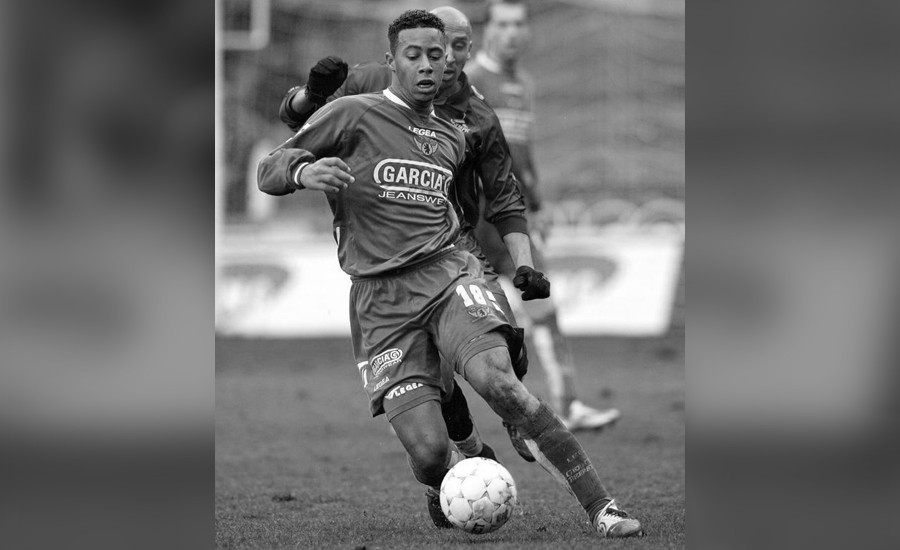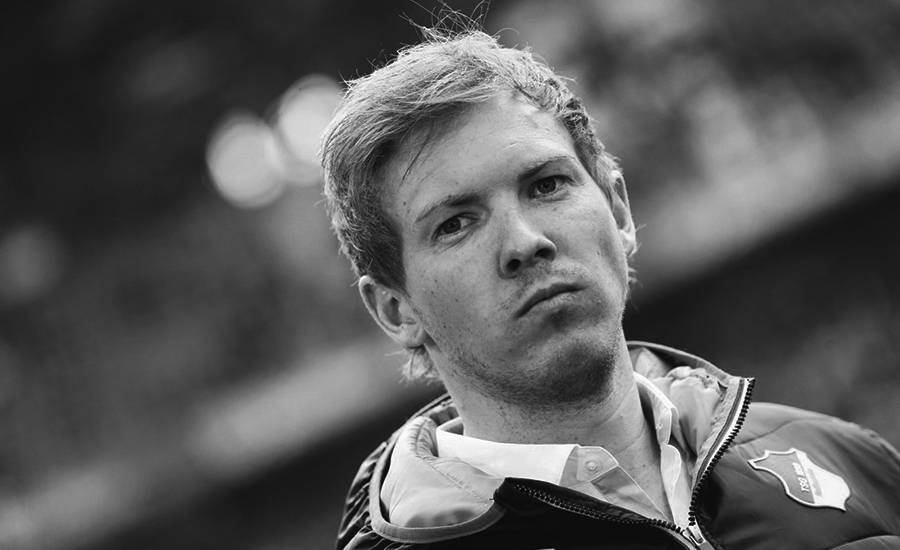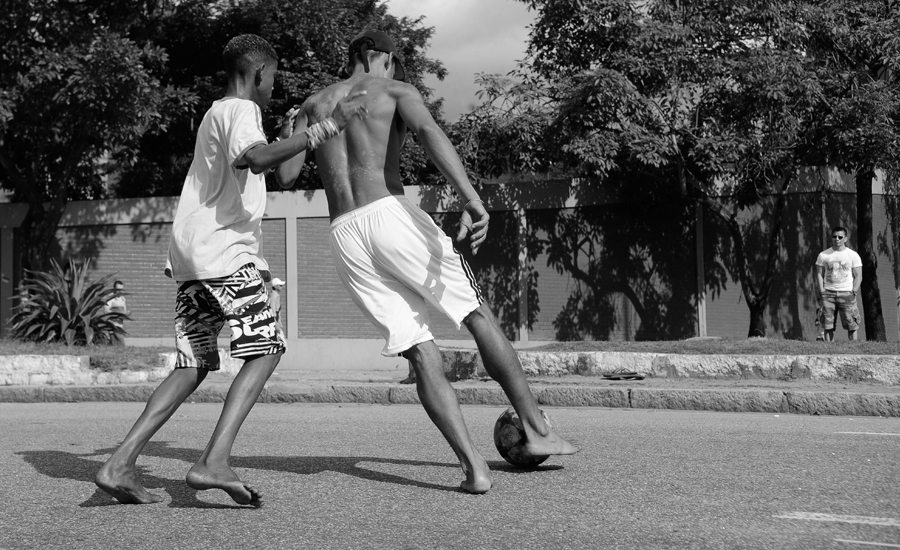Eat or be eaten
Henk Mariman has already had quite a career in football. Having worked for a.o. the Youth Academies of Sporting Lokeren, Germinal Beerschot and club Bruges, he now travels the world. As ‘Head of Football Development’ at Double Pass he analyses and advises clubs and federations worldwide. After all these years his eyes are still shining. Mariman speaks with the passion of a young boy who has just seen Messi score a goal for the first time in his life. We had a lengthy conversation about cultural differences, so-called ecosystems in sports and of course the myths of football. “In Spain of all places I learned that training within small spaces is not the Holy Grail of youth formation.”
Henk, let us go back in time for a second. You were one of the driving people behind the so-called ‘Belgian Project’ of Ajax, in the years of partnership with Germinal Beerschot. Many of today’s Red Devils were young players in that project.
“Yes, that was a wonderful time. I had the pleasure to work with the one and only Urbain Haesaert. Other top colleagues of that period were Simon Tahamata and Marc Noë, who still works at the club. We had an excellent team of youth coaches back then. Intelligent people who were keeping eachother sharp. There was indeed a lot of player potential. VErtonghen, Vermaelen, Alderweireld, Naingolan, Dembélé… very diverse actually, just like the city of Antwerp. I remember well how we introduced Marc Brys to the young Moussa Dembélé. Marc was manager of the first team just like today. I remember him saying: ‘well, he is obviously crazy talented, but he doesn’t have the guts for professional football yet.’ (laughs) Luckily the kid had a very good entourage there, who knew exactly how to work with him. We just had the knowhow and most of all we shared one vision. Winning games was not the objective there. Creating great players was. We would always encourage our youngsters to try and find solutions in difficult situations, and to always keep playing an attractive game. Well, those were the days. Good times.”
When you see all those guys play foot these days, do you feel any pride?
Of course I do. The Red Devils are one of the remarkable stories of today’s international football. There is so much potential and talent in our national team. Top players, every single one of them. Many strong personalities as well. So sure we are all proud about the quality of that team. Rightfully so. Of course, if we are completely honest… .”
Go on…
“…we have to admit that we don’t get to see that level of play in our own competition. (thinks quietly) Look, seventy percent of the players in the Jupiler Pro League comes from abroad. That is… simply too much. These players are not the hot international profiles on the market, because we can not afford those anymore. Then what we also see is a growing amount of talented young players going abroad instead of siging up for a Belgian club. Why that is? Money reasons, of course. But of course, that is not the only reason why.”
So what causes that exodus then?
“There are a few different reasons. First, we lack full time professional trainers in our Youth Academies. Belgium only has… five or six that I can think of. In England we are talking an average of 17 full time coaches per club (!) In many other countries, not just the bigger competitions by the way, you can see how money is being invested in professional youth coaching. But here in Belgium, it is a rare phenomenon. I don’t want to wine or complain, but it is a plain fact we can’t ignore. In a smaller country like ours, youth formation should always be a priority. Because we simply can not win the battle for talent financially. There is a huge gap with the richer competitions. So let us focus on creating value and doing smart business by investing in all that young talent, and create an environment that makes them want to stay. You just have to wander through our cities and visit a few parks to discover the potential of our younger generations. It is a matter of choice. We should not talk about it, but just do it.”
Do you think there would be room for initiatives outside football clubs? Like a regional academy that brings together prodigies?
“I strongly believe we should keep educating our players within clubs. Look, we are talking topsport here. Competition between clubs will always be part of the game. Every club can develop their own vision, make their own choices. If your project is appealing to a player and his entourage, a club can definitely convince a player to stay and work his way into the first team. Every club that wants to stay competitive will have to this, by the way. There is really no choice. Investing in youth formation will be a choice for survival. Eat or be eaten.”
Your conviction is based on experience, right? You get to audit clubs all over the world for Double Pass. Your work field goes from Denmark over Japan to Brazil…
“I started travelling when I was doing research for my book ‘de Voetbalmethode’ (note: The Football Method). I visited youth formations all around Europe. In The Netherlands I visited FC Groningen, AZ Alkmaar, De Graafschap, Sparta Rotterdam, NEC Nijmegen and Feyenoord Rotterdam. Then I went to FC Köln in Germany, Espanyol and Barcelona in Spain and ultimately Southampton, Chelsea, Tottenham Hotspur and Crystal Palace in England. Today Double Pass is active in seven countries. What we see everywhere we go is that in order to get youth players to work their way to a first team, the club needs to develop a real philosophy. We’ve discovered that succesfull clubs have, at some point in time, asked the million dollar question: ‘are we doing everything we can to prepare our players for the first team?’. Mostly they have done two things right. First they have established what I would calll “one ecosystem”. It means that the vision of the first team and the vision of the formation are one and the same. It sounds logical, but apparently it’s one of the hardest things to do because In Belgium we have not seen it once. Worse, we notice how within one youth academy trainers are rarely on the same page. Plus, what you often see is a total change of vision and course when a manager of the first team leaves a club. A club changes overnight. That is not the definition of stability. Young players and their entourage see those things. That is often the reason why they leave. Not just because of money issues.”
What is that second thing those clubs did ‘right’?
“They dare to choose for innovators. Like Hoffenheim has done with Jonas Nagelsmann, a twenty nine year old coach who thinks out of the box like nobody else. He proves to be succesfull at the same time. He keeps surprising. He lays out a philosophy and stays true to it. Innovators like him need to be attracted. It is also smart to keep them involved with youth formation. That way they can help shaping the unique philosophy of a club, and become an ambassador of that vision. There is nothing more important to a club than a manager who can read the potential of young players. A coach like that will always make the club richer. Because talented youth players are the potential capital of every club.”
Doesn’t Belgium have potential innovators like Nagelsmann?
“Oh, but of course. But they rarely get the opportunity to prove their worth. Again, these coaches have developed a competence that is crucial. They can ‘read’ players better than others. But take a look at the top coaches in the JPL. How many of them have worked with youth in their career…? I rest my case.”
Such a great job you have. You get to travel the world to audit clubs. Discover different cultures. It is the best of both worlds!
“Say that again. I have been to Denmark last year, and before that I got to fully discover the ins and outs of a Brazilian football club. Very educational. Anyone in football should leave their comfort zone from time to time, to discover. If there is one thing I learned is how great the influence of local culture can be on the management or vision of a sports club.”
Power distance
Can you give us some examples please?
“Well, let me start in my home country. Traditionally in Belgium there is still some sort of distance between a pupil and his tutor. I call that the ‘power distance’. In football it causes a problem. Players tend to be followers, not leaders. They won’t easily challenge their coaches, who have mostly developed the habit of shouting directions at them ALL the time. So consequences are obvious. Players start thinking for themselves at higher age. Same thing goes for the coaches by the way. They are used to following directions from their technical directors, without asking too many questions. So innovation… is not exactly something that flourishes here. The ‘power distance’ of course has benefits. We learn to be disciplined at a young age. Later in our careers and lives that very ability helps us. Definitely in sports discipline is essential.”
Any examples from other countries?
“Many. In Denmark there is almost NO ‘power distance’. Coaches will demand a say in everything. They demand to be heard about vision, about management of their club, about training methods. Interaction on the pitch is also very high there. You can see how everyone is used to communicate at all times. The opposite situation we saw at Galatasaray. A very fascinating club where hierarchy was strongly embedded. Coaches and players are not used to participating in the development of strategy or vision. They follow the club’s management at all times. Introducing innovation in such a club is a real challenge.”
So how do you go about it then? How do you change a club like that?
“In Galatasaray we worked step by step. Trying to make people step out of their comfort zones. As soon as we shared insights that were hard to ignore, we left it in the hands of the club’s top managers to make a decision about the necessary changes. It worked because in the end we respected every decision they made. Look, it’s actually quite simple. If you respect the culture of the people and their club, it is so much easier to collaborate with them. But you have to find out who they are, what defines them, and share that insight with them. We try to name their values and we do it using the Hofstede Model. As soon as everybody is on the same page we start focusing on necessary changes and where we think they have room for improvement. Mostly a club notices very quickly how it can work towards a more professional environment without losing it’s identity in the process.”
Have you discovered THE one method that always works?
“Oh no! That is of course the most important lesson. There is no such thing as one method that beats all. I see different methodologies everywhere. Every country’s different, clubs differ also. But one thing is beginning to reveal itself to be crucial. A training method, a sports philosophy, a club’s organizational structure, everything has to start with the final purpose in mind. The end product of all efforts, so to speak. In football, that is, naturally… the weekdn match. Every week effort, at all levels of the club, has to build upt to that defininf moment of succes (or not). For youth academies I would say: the end product is the 11 vs 11 formation. You can have different ways of working towards that moment when players start playing 11 vs 11. But that is the way eventually will play that game. So it has to be the focus.”
But that sounds very logical, why do you mention that even?
“Well because many people are always raving about ‘football is played on small space’, as if it is a given. But in Spain of all places I learned how that is just a theory. One day I was watching a U7 training at Espanyol Barcelona. Those kids were playing 7 against 7, on large spaces. I could not believe what I saw. ‘The sooner, the better’, they told me. Because It’s not always short passing that will solve your problem during a game. Sometimes a player will see the best solution (a free player) at the other end of the pitch. So I learned there and then that the typical fast passing game in small spaces is just one aspect of modern football. Equally important are skills such as spatial awareness, physical fitness and of course the mental ability to adapt. The latter is a crucial talent every player needs to make it to the top. Change is a constant in football, so you must adapt, always.”
So by letting children play football on large practice grounds, you get them out of their comfort zone? Because it is not something they do themselves. It means you say there is more to footbal than playing ‘pressing’?
“Indeed. Because there is. Another hype like that is the Coerver method. At some point I saw it appear everywhere, like it was supposed to be some sort of miracle method. But ask yourself… how many times would you see a Coerver exercise put into practice during a real game? Hardly ever, if not never. Stuff like that really intrigues me. We have to keep asking ourselves: ‘what will actually useful for a player later in his career? What will he actually need? I am pretty sure it won’t be a collection of exercises.”
Insight, choice, execution
Another example to illustrate that?
“Brazil. It has always ‘produced’ great footballers. We have wondered for so long about their secret recipe. What made their ‘ginga football’ so special? Science has uncovered the secret. It is simply lack of luxury. Circumstances in Brazil are suboptimal for young kids playing football, to make an understatement. In villages or city neighbourhoods spaces are sometimes big, sometimes small. Streets or terrains are rough, parks or sandy roads are rarely levelled. I mean: there is so much variation in the daily practice environment of a Brazilian player that he automatically develops reaction speed, spatial awareness and creativity. He becomes a player who does things unexpectedly, because his surroundings have taught him so. So if we want to develop a football style that is more creative like that, should we be betting on perfect pitches and state of the art artificial grass? One could wonder. Maybe we should get out more, and practice on sand, or gravel. In squares, on beaches, out in the streets.”
You speak of creativity and reaction speed. Are those skills essential to the modern game?
“Naturally. But the most important skill of all is insight. Intelligence. It is the beginning of everything. Look, during a ‘football moment’ there are three general steps. A player needs to have an insight (under pressure), make a choice next and then execute it right. In that order. Insight, choice, execution. So without insight there will never be a right choice or execution. If talent scouts should look for one talent, that would be it: insight.”
Should youth formation be based on that ‘insight’?
“I believe so, yes. It is what you look for, both in your coaches and players. If you have that, you can start working on the next two elements.”
So, methodology is what your professional life is all about. You even write books about it. Any ‘golden rules’ you want to share with us?
“In my book I write about 11 principals. I am not going to explain all of them here, that would spoil the fun of reading. So if you want to know what these principals are, you will have to buy the book online. (laughs)”
“A player needs to have an insight (under pressure), make a choice next and then execute it right. In that order. Insight, choice, execution. So without insight there will never be a right choice or execution. If talent scouts should look for one talent, that’s exactly it: insight.”
Henk Mariman









